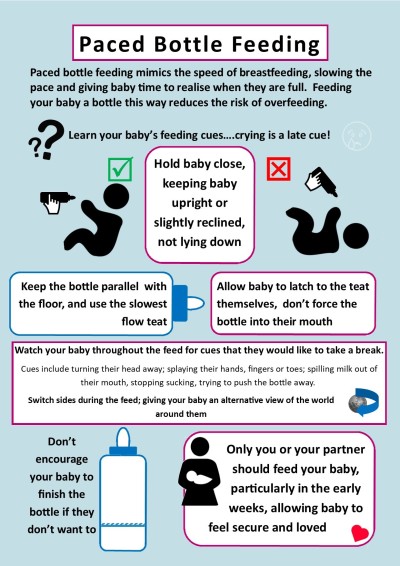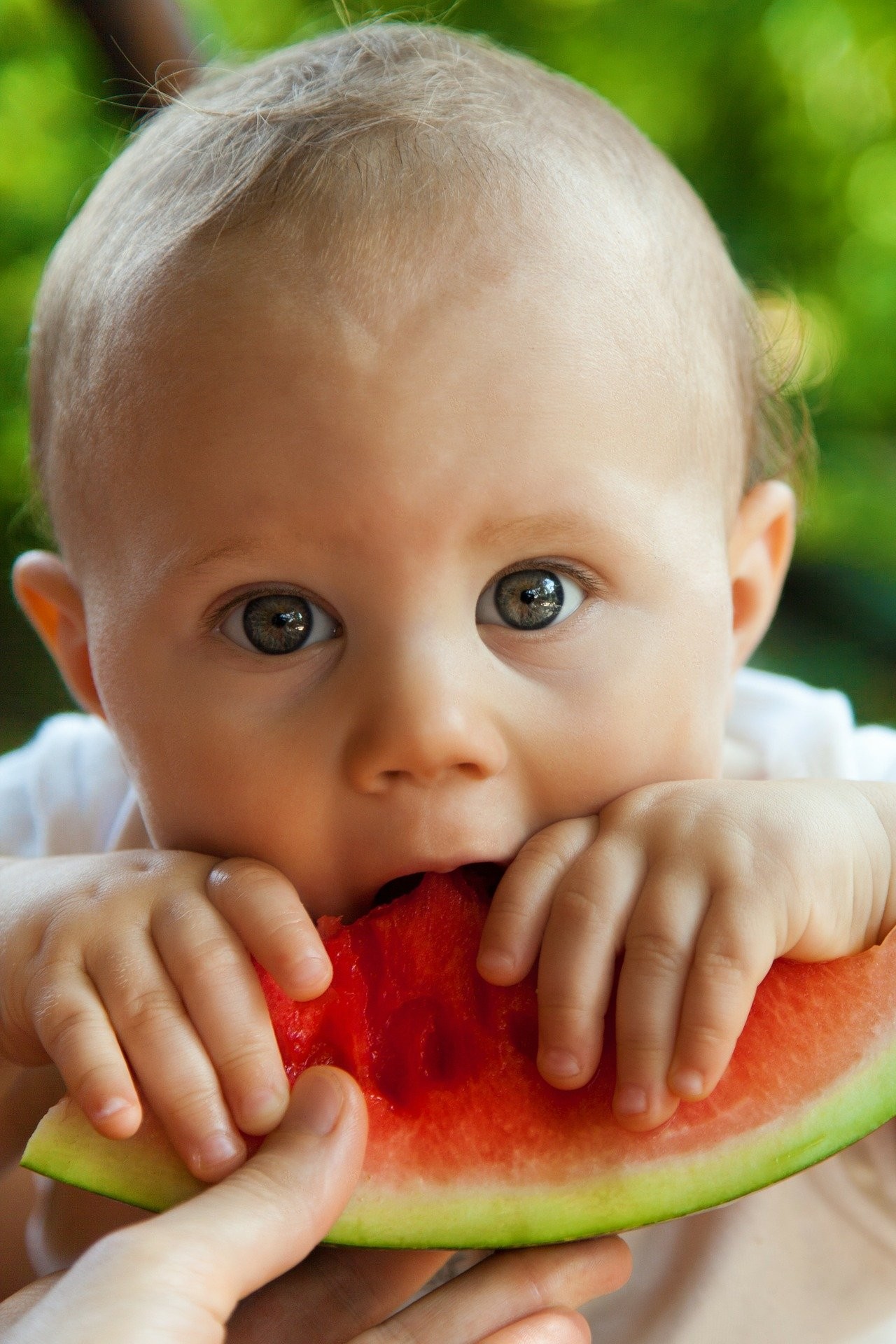A guide to bottle feeding
Some mothers breastfeed, whereas other mothers use infant formula milk and some mothers find that they use a combination. Introducing infant formula will reduce the amount of breast milk you will produce. This may make breastfeeding more difficult.
To make an informed decision about choosing the right formula milk, please refer to UNICEF Baby Friendly - Guide to Bottle Feeding Leaflet.
Sterilising infant feeding equipment
It's important to sterilise all your baby's feeding equipment, including bottles and teats, until they are at least 12 months old. For further information, please refer to the NHS - Sterilising Baby Bottles.
Infant formula milk
Infant formula milk usually comes in powder form and is based on processed, skimmed cow's milk and is treated so babies can digest it. Vegetable oils, vitamins, minerals and fatty acids are added to make sure the milk contains the vitamins and minerals that young babies need. This information will be on the ingredients list of the packet.
Infant formula powders are not sterile so it is important to follow the cleaning and sterilising instructions.
Formula is either whey dominant or casein dominant depending on the balance of proteins it contains. It may also be referred to as stage one or stage two milk. First stage milk is all a baby needs up to the age of 12 months; after the age of one they can go on to drink full-fat cow's, sheep or goat's milk.
Whey dominant milk is thought to be easier to digest than casein dominant milk, so should always be the first formula you give your baby.
There is little nutritional difference in the two forms of milk, so if whey dominant milk suits your baby, they can stay on it for the first year.
Using infant formula milk
Powdered infant formula milk must be prepared as carefully as possible.
It is not a sterile product and even though tins and packets of powdered milk are sealed they can contain bacteria such as cronobacter sakazakii (formerly know as enterobacter sakazakii) and, more rarely, salmonella.
If the feed is not prepared safely, these bacteria can cause infections. Infections are very rare, but can be life threatening.
Formula must therefore be made up with water hot enough to kill bacteria, at least 70oC.
This means boiling the kettle and leaving it to cool for no longer than 30 minutes.
Very young babies are at most risk and it is better to use sterile liquid ready to feed products for premature or low weight babies.
If you are using formula, mix the formula and water and cool quickly to feeding temperature in cold water.
It is also essential to make up a fresh bottle for each feed. Throw away unused formula within 2 hours. Bacteria multiply rapidly at room temperature and can even survive and multiply slowly in some fridges, so storing formula milk for any length of time increases the risk.
Ready to feed infant formula milk
Ready to feed infant formula milk is available in cartons. These are generally more expensive than powdered milk. Once opened, the carton should be stored in the fridge with the cut corner turned down. Do not store for longer than 24 hours.
If you have any worries about the infant formula milk you are giving your baby, ask your Midwife, Health Visitor or GP for further information.
Milk preparation machines
There remains insufficient evidence that these machines are safe in the preparation of powdered infant formula.
Use of bottled water
Bottled water is not a healthier choice than tap water and usually is not sterile. In fact, some natural mineral waters are not suitable for babies because of the amount of minerals they contain. If you need to use bottled water, any bottled water that is labelled 'natural mineral water' might contain too much sodium for babies.
If you are giving bottled water to babies under six months, you should boil and cool it just like tap water. If you need to use bottled water to make up infant formula (for babies of any age) you should boil it and allow it to cool for no more than half an hour.
Useful links
Bottles
All feeding bottles are made of food-grade plastic, but some shapes and patterns on bottles can make them difficult to clean. A simple, easy-to-clean bottle is probably best.
You might find it useful to have about six bottles and teats, so you can always have at least one or two bottles clean, sterilised and ready for use. It is best if you can buy new bottles. Check regularly that the bottles are in good condition. If they are badly scratched, you will not be able to sterilise them properly.
It is important to sterilise all your baby's feeding equipment, including bottles and teats, until they are at least 12 months old.
Teats
There is no evidence that one teat is better than another. It is fine to try different teats and use the one that suits your baby best.
Despite manufacturers advertising claims, no bottle teat is like a breast. In particular, teats do not lengthen like the human breast/nipple
You should always buy new teats and regularly check that teats are not worn or damaged.
Teats can be made from rubber or silicone and come in different shapes and with different hole sizes. There is some evidence that it is easier for a baby to use a simple soft long teat rather than orthodontic teats. However, it is best to experiment and you may have to try several before you find the one that suits your baby.
The size of the hole in the teat is what affects the variability in milk flow. As a starting guide, the milk should drip out of the upturned bottle at the rate of one drop per second. If the hole is too small the milk flow may be too slow for the baby. If it is too big the milk will come too fast. If the milk is flowing too fast for the baby, he may drool the milk in order to protect his airway. In this case a teat with a smaller hole would be advisable.
Bottle–feeding is a time for social interaction, not just a method of delivering food. Paced bottle feeding mimics the speed of breastfeeding, slowing the pace and giving baby time to realise when they are full. Feeding your baby a bottle in this way reduces the risk of overfeeding.
Top tips:
- Learn your baby's feeding cues - crying is a late cue.
- Hold baby close, keeping baby upright or slightly reclined, not lying down. Baby should be held close to their carer's body and should be able to make eye contact. Drinking while the head is turned sideways or tilted back makes it more difficult for baby to swallow.
- Keep the bottle parallel with the floor, and use the slowest flow teat.
- Allow baby to latch to the teat themselves, don't force the bottle into their mouth. The reflexes the baby is born with will help them to bottle–feed. If the teat is brushed against their lips, they will open their mouth wide and dart their tongue down. At that point they should be helped to draw the teat in. The bottle should be held horizontal to the ground, tilted just enough to ensure the baby is taking milk, not air, through the teat.
- Watch your baby throughout the feed for cues that they would like to take a break. Babies may need short breaks during their feed; they may also need to burp sometimes. Interrupting the feed from time to time also gives the baby a chance to register how ‘full’ they are, and thus control their intake. This will reduce the chances that the baby will overfeed and put on more weight than is appropriate for health. Cues include turning their head away; splaying their hands, fingers or toes; spilling milk out of their mouth; stopping sucking; trying to push the bottle away. Switch sides during the feed; giving the baby an alternative view of the world around them.
- Don't encourage your baby to finish the bottle if they don't want to. Pacing the feed will give the baby more control over their intake of breast or formula milk.
- Only you or your partner should feed your baby, particularly in the early weeks, allowing baby to feel secure and loved. Babies need to be able to relate to those caring for them so it is best to keep the number of people who feed your baby to as few as possible.

If your baby shows signs of distress during the feed, encourage them to let go of the teat and sit them up, or put them over your shoulder, and see if they need to burp. Continue feeding them when he seems more comfortable.
Do not feed baby in a lying-down position as this is dangerous, they could choke or formula may get into their lungs. Formula may also travel from the back of the baby's throat up through the tubes into the middle ear, causing ear infections.
NEVER leave baby unattended while feeding. This is dangerous and falling asleep with a bottle also allows the sugary formula to stay in contact with teeth, increasing tooth decay.
Crying
All babies cry - and some cry a lot. Crying is your baby’s way of communicating that they need comfort and care. Sometimes it is easy to work out what they want, and sometimes it is not. You might find that there are times when your baby tends to cry a lot and cannot be comforted. Early evening is the most common time for this to happen. This can be hard on you as it is often the time when you are most tired and least able to cope. Whilst some crying is perfectly normal, there is usually a reason for excessive crying.
If you are concerned about your baby, please contact your Midwife, Health Visitor or GP.
Resources:
- Visit NHS - Soothing a crying baby for further information
- ICON - Babies Cry You Can Cope - information and resources
Colic
Excessive crying could be a sign your baby has colic. Everyone agrees that colic exists but no one knows what causes it. Some doctors think it’s a kind of stomach cramp, and it does seem to cause the kind of pain that goes with waves of stomach pain - miserable and distressed, stopping for a moment or two, then starting up again. The crying can go on for some hours and there may be little you can do except try and comfort your baby and wait for the crying to pass.
Keeping a record can also help you identify the times when you need extra help. You could also think about possible changes to your routine. For example, if your baby tends to cry a lot in the afternoon and you have got into the habit of going out in the morning, try going out in the afternoon instead and see if that helps.
Coping with a colicky baby is extremely stressful. If nothing helps, ask your GP or Health Visitor to refer you to a Paediatrician. It is hard to imagine, but this stage should only last a few weeks at the most. It may also help to remind yourself that you are not causing the problem and it is not under your control. Having a decent meal every day will help you to keep up your energy levels. If a crying baby takes up your whole evening you could try and make lunch your main meal. Visit NHS - Colic for more information.
Sickness and vomiting
Some babies bring up more milk than others during or just after a feed. This is called ' regurgitation' or 'gastric reflux'. It is not unusual for babies to bring up quite a lot, but it can be upsetting when it happens and you may be worried that something is wrong. As long as your baby is gaining weight, there is usually nothing to worry about but if your baby is violently sick or appears to be in pain, or you are worried for any other reason please talk to your Health Visitor or GP.
Cover your baby's front when feeding and have a cloth or paper towels ready to mop up any mess. Check that the hole in your baby's teat is not too big, as giving milk too quickly can cause sickness. Sitting your baby upright in a baby chair after a feed can also help. The problem usually stops after six months when your baby is starting on solid foods and drinking less milk.
If your baby brings up a lot of milk, remember that they are likely to be hungry again quite quickly. Don't force your baby to take on more milk than they want during a feed. Remember, every baby is different. Some prefer to feed little and often.
Constipation
This may be resolved by checking the way in which the feed is made up, since errors are not uncommon. Always stick to the recommended amount of Infant Formula Milk Powder. Using too much can make your baby constipated or thirsty. Do not water down the formula as this can be harmful to your baby and do not give babies under 6 months of age any fruit juice. If you think your baby is constipated, seek advice from your GP.
Breastfed babies don't usually get constipated. If your baby is under eight weeks old and has not passed a stool for a few days, talk to your health visitor or GP.
The safest way of feeding your baby from home is to carry measured amount of milk powder in a small clean and dry container, a flask of boiled hot water and an empty sterilised feeding bottle.
Make up a fresh feed whenever you need it.
The water must still be hot when you use it, otherwise any bacteria in the Milk Powder may not be destroyed. Remember to cool the bottle under cold running water before you use it.
Alternatively you could use the 'ready to drink' Infant Formula when you are away from home.
Transporting feed to nursery or childminders
Guidelines from the Department of Health
If it is not possible to make up a fresh feed, or you need to transport a feed to a nursery or childminder, you should prepare the feed at home and cool it in the back of the fridge for at least one hour. Take it out of the fridge just before you leave, and carry it in a cool bag with an ice pack and use it within 4 hours. If you reach your destination within 4 hours take it out of the cool bag and store in the bag of the fridge for 24 hours. Warm for no more than 15 minutes.
How do I know if my baby is hungry?
You will soon learn to recognise signs of hunger in your baby. If you can spot these before they are crying for food, they will be easier to feed.
When they wake up they will start to move about, this would be a good time to start preparing the feed. They will then begin to move their head and mouth around, finally they will find something to suck, usually their fingers, this would be a good time to offer your baby some milk.
How often should bottle–fed babies feed?
You should feed your baby as much as they want, as often as they ask, provided they are not positing significant amounts or being sick.
All babies should be fed responsively, when they show feeding cues, regardless of the milk they are receiving. The ‘guide’ section on the tin or packet is just a guide. The information on the formula tins or cartons often suggests feeding babies larger volumes of milk, less frequently. Most babies would prefer to take smaller more frequent feeds.
Newborn babies may take quite small volumes to start with, but by the end of the first week of life most babies will ask for approximately 150–200ml per kg per day – although this will vary from baby to baby – until they are six months old.
How do I avoid overfeeding?
Giving lots of milk in one feed will not necessarily enable your baby to go longer between feeds. It is just as likely to make them sick, or put on too much weight.
Don’t try and make them finish the bottle if they don’t seem to want it.
How do I know if my baby is getting enough milk?
Your baby’s weight gain and what is in the nappy will tell you whether he is getting enough to eat.
Your baby will be producing at least six wet nappies a day after the first day or so. These should be soaked through with clear or pale yellow urine.
For the first few days after birth your baby will pass dark sticky stools (meconium). After the first week your baby should pass pale yellow or yellowish-brown stools. Individual bowel habits vary, but as a general rule, bottle fed babies will pass stools that are more solid, but less frequent, than those of breastfed babies. You should contact your midwife or health visitor if the number of stools per day changes or your baby shows any signs of discomfort or straining while passing stool.
For answers to other questions go to NHS website - Formula milk: common questions.


